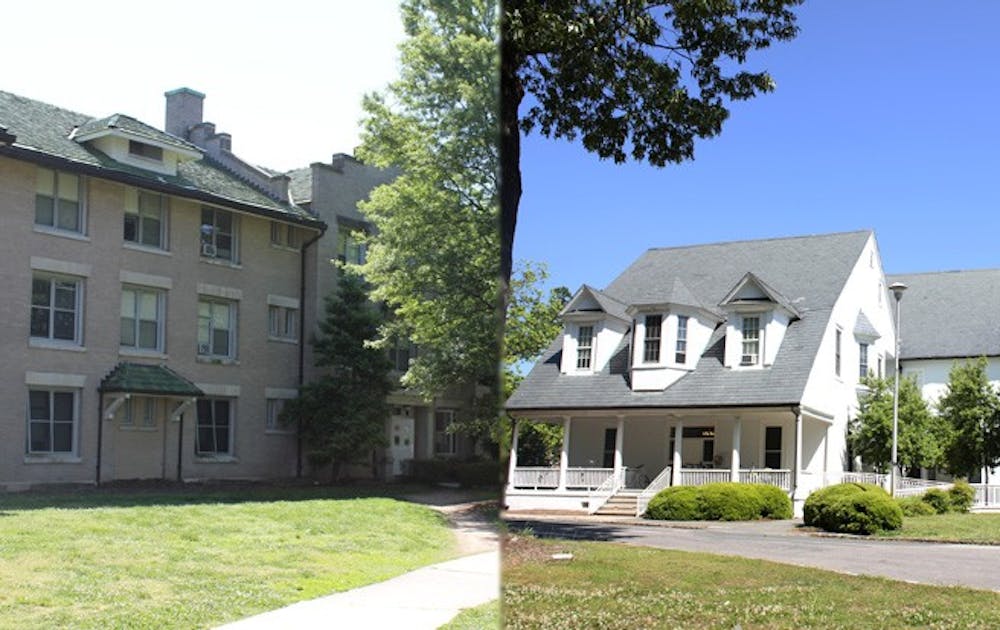updated at 8:40a.m.
Duke’s oldest dormitories are in store for a facelift in the coming years.
After recently surveying many of Duke’s oldest buildings, administrators have laid out a tentative long-term plan for renovating several University residence halls. Although project completion should not be expected sooner than 10 to 15 years from now, both East and West campuses will eventually see new dormitory buildings and the decommissioning of others and students may stop living on Central Campus.
“It’s very important to the University that the conditions of the residence halls are top priority, and the University is looking very seriously about how to renovate them and how to develop that housing master plan of renovations because it is a concern,” said Rick Johnson, assistant vice president of housing and dining.
In January, Dudley Willis, project manager for facilities management, completed a survey of all residence halls that involved the work of architecture and engineering firm Clark Nexsen and Vanderweil Engineers. The survey involved an overall assessment of the dormitories based on current North Carolina building codes. The two firms made recommendations on what could be done to improve the buildings, many of which date back to the 1930s.
“The primary goal was to make the buildings functional,” Willis said. “The focus is not the cosmetic changes but to make sure that the buildings work. [We are] trying to make them convenient for the students and people who use the buildings.”
The survey showed that Epworth and Aycock residence halls are the two facilities that need the most renovation on East Campus, with Jarvis residence hall also in need of significant work, Trask said.
The administration plans to completely renovate Aycock and Jarvis residence halls, and Epworth will be decommissioned. Epworth, which is more than 118 years old, has a wood frame and is no longer fit to be used as a residence hall, Trask noted.
The administration expects that a new residence hall will be built on East Campus, either in space behind Carr Building or behind Bell Tower residence hall. The new dormitory will be built in the same style as Bell Tower but without the tower, Trask said.
On West Campus, administrators will focus on Crowell and Craven quadrangles, where air conditioning and other utilities such as fire alarms, plumbing and electrical systems will be updated. Renovations will also be made to Edens Quadrangle. The building plans will be extend beyond cosmetic and utility concerns but will not be a complete renovation, Trask said.
The estimated cost of each renovation to the respective dormitories is between $15 million and $20 million, Trask added.
Additionally, the University is trying to raise money for new residence halls on West so that students may eventually be phased out of housing on Central Campus, said Steve Nowicki, dean and vice provost of undergraduate education.
“The success of K4 has led me and others to understand that we need K5 and K6 because in the long run, we’re going to take students off of Central and put them in new space,” Nowicki said.
Funding for these projects will rely primarily on donors, Nowicki said, and some have already contributed to the fund for new residence halls. He said acquiring money for the renovations, however, has proven more difficult.
The new residence halls could cost about $25 million each to build, Trask said.
Johnson noted that funding needs to be acquired before these aspects of the project can be pursued. He said minor cosmetic renovations made to Jarvis last summer were costly, and these future plans are much more expensive.
“We improved the bathrooms, the kitchens and the lounges and even that was expensive,” Johnson said. “That [cost] a couple million to do that work. Once you start replacing the entire electrical system, plumbing system and perhaps add [air conditioning] to the building—that’s what costs money.”
Trask said added that there is a possibility to get funds from students’ housing fees.
Nowicki noted that the University has other items on its laundry list of building projects that may be addressed first—including renovations to the West Union Building and Physics Building, as well as construction of the Duke Environment Hall—but residential concerns are not to be overlooked.
“Everyone from the Board of Trustees to [President Richard Brodhead] to [Provost Peter Lange] to me understand that we really need to invest in our residential infrastructure,” Nowicki said.
Editor's Note: This article has been updated to reflect the timeline in which the residential survey was completed. This new version also reflects estimate costs for respective residential renovations and the construction of a new residential facility.
Get The Chronicle straight to your inbox
Signup for our weekly newsletter. Cancel at any time.

